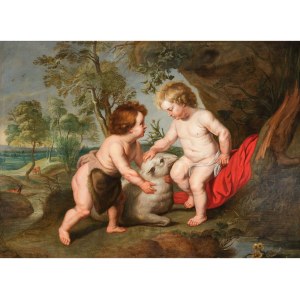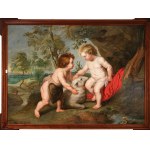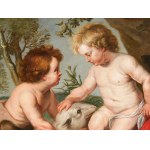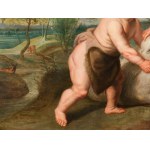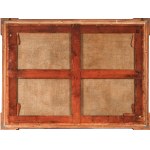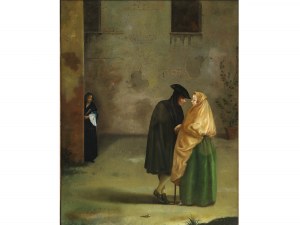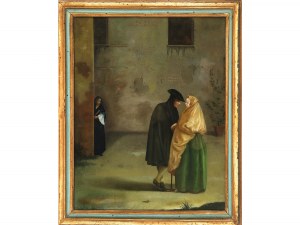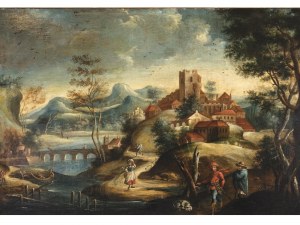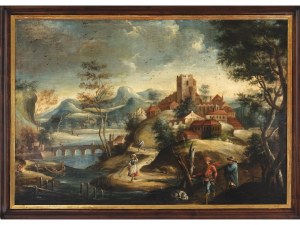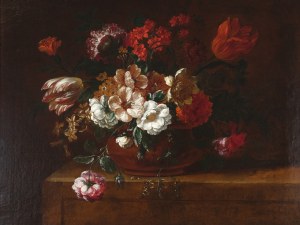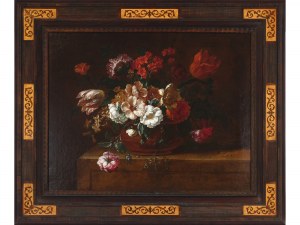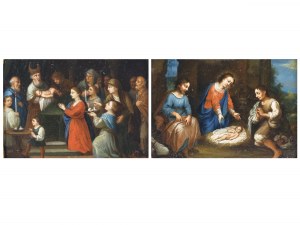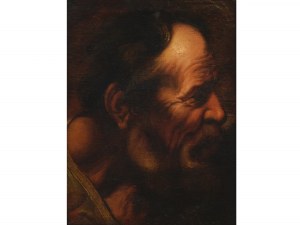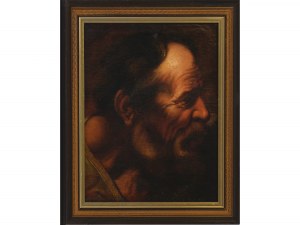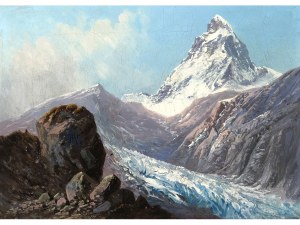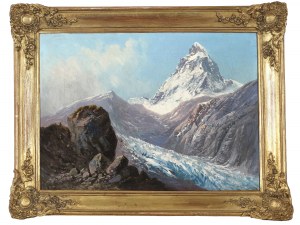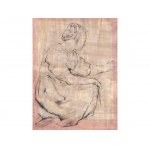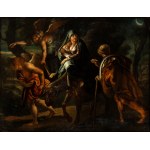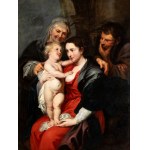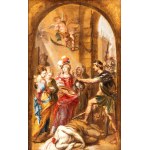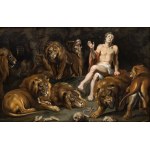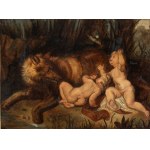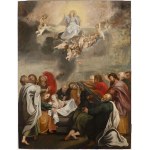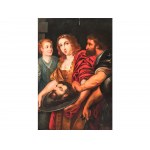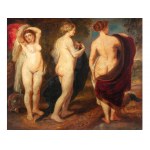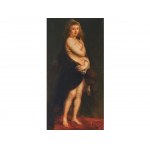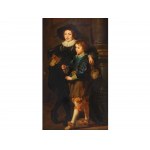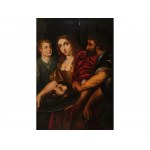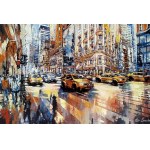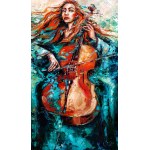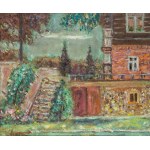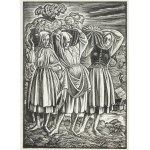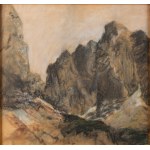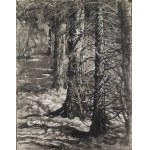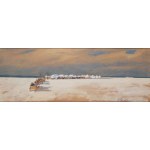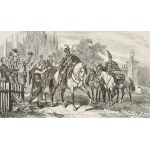Peter Paul Rubens
Siegen 1577 - 1644 Antwerp, workshop, attributed
The Child Jesus and the Boy John
Oil on canvas
116 x 153 cm, with frame 129 x 168 cm
Provenance:
Roman aristocratic property, from a palazzo in Rome
Private collection Hamburg
This particularly lovely scene of Jesus and John the Baptist as children, playing with the lamb, is one of the most famous subjects of the Flemish Baroque painter Peter Paul Rubens (1577-1640). The painting comes from a private collection in Hamburg and goes back to a Roman aristocratic estate ("Roman version").
During a visit to the auction house, art expert Prof. Dr. Nils Büttner provided expert information that the paintings of the Rubens workshop have a grey grounding. This can also be found in this painting, which we therefore believe to be a creation from the workshop of Peter Paul Rubens. The work stands out in comparison to the repetitions of this popular subject after an original by Rubens that is believed to have been lost, in its great quality. It is worth mentioning that world-class museums such as the Alte Pinakothek in Munich and the National Museum in Warsaw also possess repetitions of Rubens' workshop of the same subject.
The "Painter Prince"
Who was Peter Paul Rubens? The Flemish painter was born in Siegen/Westphalia in 1577. After learning the craft of painting from Tobias Verhaecht, Adam van Noort and Otto van Veen, he became part of the Guild of St. Luke in Antwerp from 1598 onwards. At the beginning of the 17th century he spent time in Italy and Spain. He was particularly influenced by Italian painting, especially Renaissance works by Titian or those of antiquity, which he was able to study through the patronage of the court in Mantua. After his return to Antwerp, his marriage and subsequent employment as court painter to the governor's family, he created a studio that is considered the largest artist's workshop in the Baroque period. As the so-called "Painter Prince", he carried out numerous ecclesiastical and secular commissions.
Jesus and John the Baptist as children
Jesus and John the Baptist are depicted as children, petting a lamb, in an idyllic landscape. The motif comes from biblical and apocryphal texts dealing with Jesus' childhood, namely how John the Baptist greets his cousin Jesus. The former presents him with the Lamb, according to his testimony in John's Gospel (1:29): "The next day he saw Jesus coming towards him and said, "Behold, the Lamb of God, who takes away the sin of the world."" The relationship between the two children is a reference to the baptism of Christ.
The luminous centre is formed by the two half-naked child figures in a vividly dynamic, pyramidal composition, with the lively animal between them. John, with a crown of reddish-brown hair and characteristic fur overcoat, is shown lunging and touching the neck of the lamb kneeling on the forest floor with his right hand. His head is resting on the knee of the infant Jesus, who is gazing pensively down at the animal and stroking its head. He is also depicted in virtuoso captured movement; carefully stepping up with his right foot so as not to injure the lamb's foreleg. At the same time, this suggests the bond between Christ and the Lamb as Agnus Dei: he was destined to be the Lamb of God from his birth. His blond curls are illuminated by a light source, with his head forming the highest point of the group of figures. He is further framed by the dark rocky outcrop that gapes over his head. Possibly this rock offers shelter for a short rest? However, it also gives the impression that the Christ child has just emerged from a dark cave, whereby this could already refer to the resurrection, underlined by the lamb of God as a symbol of that very resurrection. Furthermore, the red cloth points to the Passion of Christ. In addition, the pond on the right in the foreground and the watercourse behind John could indicate the future baptism of Christ. The sky seems to be already slightly cloudy - could this reflect the transition from a carefree, untroubled childhood to the later Passion of Christ? The saturated green tones and the clear course of the river, however, suggest an auspicious, spring-like mood of nature, which the painter has captured in a decidedly careful manner.
Colour and Light
The painting's expressiveness is enhanced by the skilful use of colour and light. The enthralling overall configuration is therefore underlined by a highly colouristic effect. Not only the light-dark contrasts within the landscape draw the eye to the centre of the painting, but also the expressively designed flesh parts, which are composed of a mixture of red, yellow, and blue. This colouring in the design of the skin, typical for Rubens, additionally emphasises the luminous flesh with modelled penumbra. It is especially the elements of colour design and the incidence of light that make the scene glow masterfully and show the viewer how Rubens further developed classical painting through the virtuoso dynamism of the Baroque. Rubens exerted a great influence on the successors of Dutch painting.
Workshop Processes
The dignified expressiveness of the painting is particularly evident in the playful depiction of children set in a landscape. This reflects a popular theme in Rubens' oeuvre; as a comparative example, the painting The Fruit Garland (Alte Pinakothek, Munich) should be mentioned here. This was executed by the Painter Prince together with Frans Snyders (1579-1657) and Jan Wildens (1586-1653). In a multi-stage working process, most of the paintings were actually executed by Rubens' workshop based on his sketches, although this was strictly controlled by Rubens. His workshop was immensely productive, and the way it worked can be compared more to a manufactory, especially because of the large number of works executed. Rubens also employed independent masters who were responsible for certain details, for example specialising in landscape painting.
Distribution of Rubens' compositions
Rubens' detailed preparatory drawings and sketches not only enabled him to work quickly and in great detail in his own workshop; he also used other media such as woodcuts and copper engravings to disseminate and reproduce his works. Christoffel Jegher (1596-1652), who worked for Rubens, produced a woodcut of the same subject based on Rubens' design in mirrored façon (British Museum R,4.2). It is a woodcut in chiaroscuro, made around 1632-36, during Rubens' lifetime. In the lower left margin the monogram "C.I" of the artist as well as "P. P. Rubens delin./ & excudit" is visible. This clearly shows that the idea for the composition and individual details came from Rubens himself. Compared to the painting, the correspondence in physiognomic details such as the fingers and toes or the meaty musculature on the arms and legs is particularly noteworthy, as is the finely executed landscape with the bird perched on an elevated branch.
It is known that Rubens made "improvements" in the final version of some of his works. An important feature is the posture of John, who in the Roman version does not clasp the neck of the lamb with both hands, but only appears to pat the animal's flank with his right hand. This reduces the animal's presentational display and allows for an intimate communion between the protagonists and the lamb. Numerous other woodcuts from later times exist that take up this popular pictorial theme with the same or similar composition by Rubens. Furthermore, there are numerous woodcuts, copperplate engravings or oil paintings that fetched high prices at auctions.
Selected comparisons
1. Schleißheim, Munich
A particularly high-quality repetition of this subject is in the Staatsgalerie in the Neues Schloss Schleißheim in Munich, titled 'Jesus and John in Youthful Age' (inv. no. 1296). It is dated around 1628, identified as "Peter Paul Rubens (School)" and has a similar format (dimensions: 121.3 x 162.5 cm). There are minimal differences between the two paintings, including the earthy foreground that is modelled in a softer manner and the different water lilies in the pond of the Roman version. There is also a more succinctly overdrawn, high forehead in the Baroque manner and a stronger colour palette in the depiction of the sky, whereby the deeper blue and the dark clouds in the Munich version have a more ominous character. Furthermore, nature, and especially the plant with the two blossoms between the two children, is more charming and idyllic in the Roman version.
2. National Museum, Warsaw
Another version is in the National Museum in Warsaw (inv. no.: M.Ob.2404 MNW, dimensions: 120 x 172 cm). In this repetition, the colour palette seems more restrained, as are the otherwise staged plays of light in Rubens' works. The outlines are also drawn more sharply, giving the overall image of the Warsaw version a sharp-edged expression. As a result, the conception also appears somewhat more sombre and the otherwise characteristic luminosity is muted. Furthermore, the faces in the Roman version are more chubby-cheeked, and the surface of the flesh parts is more expressively modelled.
3. Château Chenonceau, Vallée de la Loire
Another version can be found in the Salon de Louis XIV in the Château Chenonceau, Vallée de la Loire. It is attributed to Rubens and dated to 1615. In this depiction, dark clouds have already gathered, and the trees seem almost caught up in a storm. Due to the grey undertone of the overall depiction, the Chenonceau version is again more ominous than the Roman version.
4. "Spinola" Rubens
The so-called "Spinola" Rubens (dimensions: 112 x 149.5 cm) was shown as a work of Rubens in numerous exhibitions and was finally sold in 2020 at the Dorotheum as a work from Rubens' workshop, fetching a high six-figure sum. Hans Vlieghe confirmed here that it was a painting from Rubens' workshop. Deviating features of Rubens' "Spinola" are the exaggerated, high forehead with recessed chin, the greyish fur of the lamb, the strongly contrasting but less luminous skin, and the darker blue of the background.
Ostatnio oglądane
Zaloguj się aby zobaczyć listę pozycji
Ulubione
Zaloguj się aby zobaczyć listę pozycji



